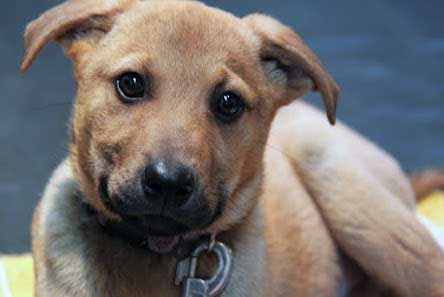How To Socialize Your Puppy
in DogsWhat does it mean to properly socialize your puppy?
Many people understand the general importance but few understand the specifics. And in this case, the devil really is in the details! Fully understanding this question is one of the best things you will ever do for your furry companions.
The most important socialization period for dogs is from roughly 3 – 14 weeks of age. Breeders are responsible for a good portion of this so always make sure your breeder is informed and conscientious about puppy development. During this time the brain is like a sponge, literally soaking up experiences, and it is very important that puppy has a lot of positive associations with the world it will be living in as an adult. If not, it is possible life-long fears could develop.
Play between puppies is critical during this time because it helps with physical development, frustration tolerance, and teaching each puppy “dog communication skills”. Singleton (litter of one) puppies are prone to a lot of behavioural issues because they miss out on interactions with litter-mates. In many standard sized litters, puppies are moved to their new home between 7 – 9 weeks and most don’t get into classes until they are 12 – 14 weeks old. That can be a huge gap without socialization. They can forget their manners and skills because a third of their life has passed already with few puppy interactions. Getting dogs into socialization classes before 10 weeks of age is ideal. You can find some great resources at the American Veterinary Society of Animal Behavior.
Good puppy classes are extremely valuable for almost all puppies. For dogs that ma
y be genetically or socially inclined to shyness, time without contact with other puppies could lead to a life-long fear of other dogs. For dogs born to be social, (Mr. Friendly who has to say “hi” to all dogs and people), puppy classes are important for teaching impulse control and polite greeting skills.

If you are not totally committed to teaching impulse control and manners daily on your own, puppy class is a great way to work in a group. Mr. Friendly should be working more on impulse control and owner focus, while a shyer puppy should be working on confidence and courage.
Impulse control and manners need to be taught to all puppies from a very early stage. This is part of socialization too! Good leadership and consistency should be in place by as early as 12 weeks.
But buyer beware, classes and socialization experiences vary greatly. What may seem like a great deal on the surface could be disastrous to your puppy’s well-being. New puppy owners should look for qualified professionals with a proven track record of helping puppies reach their maximum potential. Just as a lack of social experience can ruin a puppy, so can one or two bad socialization attempts. Owners should never leave the task of socializing their puppies to anyone else.
When searching out puppy socialization programs, look for several cornerstones:
- Puppy interactions should be structured and supervised.
- The puppy should learn value for interacting with their owner as well as other puppies.
- Exposure to noises and experiences, as well as body handling (both with the owner and with other people) should be positive experiences.
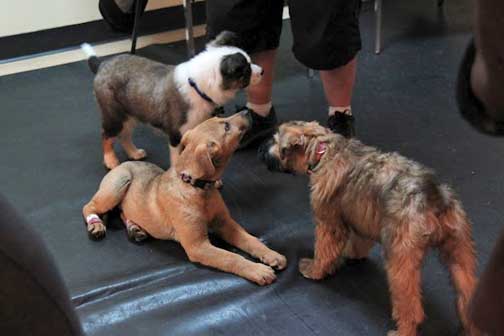 Puppy Interactions
Puppy Interactions
The puppy to puppy interactions should be structured and supervised by trainers who give care and attention to helping the session unfold well for all the puppies in the group. Some dogs need to be reinforced for brave behaviour while others need to be reinforced for gentleness or calmness. Good trainers will actually train during the play session or better yet, help the owners to see ideal interactions and actively train and shape how a puppy play session unfolds. Remember some of these puppies have been isolated for weeks and may need help acting appropriately.
Good puppy socialization classes will never let the puppies work it out themselves. They are babies, some of whom may be shy and others who may be boisterous. Often it can go well, but when it doesn’t, good trainers will save the session every time! What goes on in these early play sessions is formative and it is absolutely possible to change the way your adult dog will be with other adult dogs.
Focus on Owners
Puppy socialization classes should also offer time spent building focus and connection with the owners.
There is value in puppy to puppy play, but if they do too much of this (especially for Mr. Friendly), where is the value being built for the puppies? With each other!
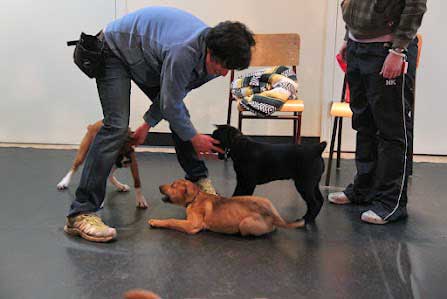 Where do we need it? With the owners!
Where do we need it? With the owners!
Same species bonding is very powerful. Good classes will give owners the tools to build a connection with their dogs that can be stronger than the bonds to other dogs. Dogs need to understand very early on that their owners provide all the wonderful things in life and outgoing puppies should be put on a “Nothing in Life for Free” program which includes permission to go play and then returning to their owner when called.
Exposure and Body Handling
In good puppy socialization there should also be exposure to handling. The gift of good instructors is that they will teach you how to work with any handling issues your puppy may have.
Detailed guidelines about how to socialize your puppy out in the real world is a bonus. Fear is the number one cause of aggression and early effective experiences can almost eradicate the fear that underlies most issues with aggression.
Don’t wait until your dog is 12 weeks old to sign up for classes – they can start as early as 8 – 10 weeks! And remember a good deal is one that provides both value and expertise.
 For puppy socialization classes look at the credentials of those running the classes. Have they been training for awhile? Are they certified? If so, does the certification program have a solid reputation and make sense for you and your puppy? This will ensure that your new furry family member gets the best education you can provide.
For puppy socialization classes look at the credentials of those running the classes. Have they been training for awhile? Are they certified? If so, does the certification program have a solid reputation and make sense for you and your puppy? This will ensure that your new furry family member gets the best education you can provide.
© 2012 SmartDog Training & Consulting. All Rights Reserved
Teaching Your Dog To Come When Called
in DogsOne of the most common training issues that dog guardians deal with are dogs that don’t respond to commands reliably, especially dogs that don’t return when called.
There is no other behaviour more important to me than being certain my dog cartoon image of dog sniffing comes to me when called; either for safety reasons or I… uh… need to leave because I’m just not comfortable lifting my leg against a tree. Time and again I see frustrated dog owners calling to their dog; who either ignore them completely (“I can’t hear you… you’re not there…”) or their dog runs to them at light speed only to turn about and gallop back into the field with a smirk on their face. (“Sucker!”)
There is a way to greatly increase the responsiveness and reliability of a ‘Recall’ and that is to provide your dog with a clear goal and target… your open hand. Teaching your dog that when they hear; “Rover… come”, that their job is to run to you and touch their nose to your hand, greatly clarifies the goal you are setting for them and increases the reliability of their response.
Getting Started
With your dog a few feet away, hold a treat between the fingers of your open hand, say your dog’s name and “Come”, wait for the very moment that their nose touches your hand before saying; “Good dog!” and release the treat. Resist the temptation to move your hand to their nose; your dog must initiate the contact. Don’t praise your dog as encouragement as they approach, you will be praising too soon. Wait for the very moment their nose touches your hand.
Once your dog is consistently touching your hand with their nose, begin holding the treat in the opposite hand from your target hand. When your dog touches your open target hand, give lots of praise and offer the treat from your opposite hand. Begin to alternate which hand is the target and which hand holds the treat so that your dog isn’t able to predict which hand holds the treat.
Gradually widen the distance between the dog and yourself before you deliver the signal for them to “come”. If they fail too often, back up to a more reliable stage before progressing.
Next, you will want to increase the challenge by choosing a moment when your dog is not paying particular attention to you, yet they are not distracted by something that will severely limit their response to your cue. (SQUIRREL!!)
Practice this next level of challenge in your home when your dog is out of your sight and in another room. Next you might try a recall in your yard where there are more potential distractions. The plan is to increase the level of potential distractions to challenge your dog’s attentiveness and response time.
Yet one more thing to keep in mind (as though I haven’t already given you enough to remember!), is that your praise can match the quality of response when you call for your dog to come to you. For example; if you say; “Rover… come!” and Rover takes a bit of time to respond and when he does, takes his sweet time about it, stopping to have a sniff at something that captures his nose but in the end did as you asked and touched his nose to your target hand, you should deliver praise but make it very simple praise. Give Rover a simple “Good boy” without petting him.
However, if you were to call for Rover while he was surrounded by seven squirrels, a pair of rabbits and five dogs that were sharing a package of bacon strips yet despite this Rover turned on his heels and ran to you with his nose stretched out to your hand – well, Rover deserves an excited “GOOD… BOY!!” some sweet lovin’ from you and a handful of treats.
OK… this is a bit of an exaggeration but you get the idea. Dogs are very capable of learning that the better their response the greater the reward.
Maintaining Reliability
Practice is important for maintenance of any behaviour. Fortunately, the recall is often used on a daily basis.
When your dog is off leash and having fun, be careful not to get into the habit of calling them to you and then immediately clipping on their leash and leaving the area they are enjoying. Your dog may soon learn that coming to you when called means the fun is at an end and may avoid returning.
When asking your dog to come to you, it is better to vary what happens after they receive praise for successfully coming when you called. You can ask them to do two or three behaviours on their return, such as “sit”, “shake a paw” or “down”. This will put some memory distance between “coming” and the potential negative of leaving the fun area.
On occasion you might also call them to return before you need to leave, reward them for returning, and then play with them for a few minutes before leaving. At times during their off-leash fun, call them to you, reward with praise, clip on their leash, ask them to sit, praise them for sitting, then unclip the leash and send them off for another five or ten minutes of fun before you ask them to return again when you need to leave.
Another great way to maintain reliability of anything your dog has learned is using “intermittent reinforcement”, whereby a treat is delivered randomly, which keeps your dog guessing as to when a treat is given and helps to maintain the quality of the recall. Make certain a treat is delivered at least one of every three times.
What To Do If Your Dog Fails
If you’ve called to your dog twice and they don’t respond, the best thing to do is to walk half the distance between the two of you, which emphasizes your presence, and try again. Do not use an angry or frustrated tone to your voice. This may only cause your dog hesitancy to return to you.
If they still don’t respond your only course is to walk calmly and quietly to them, take hold of their collar, clip on the leash and give them the silent treatment as you leave. Do not scold them as you take hold of your dog. If you do scold your dog, even though they did not respond to your call, your scolding will teach your dog that reconnecting with you can be a negative experience and they may be hesitant to come to you the next time you call.
At the same time you cannot be positive about having to go to them and gather your dog so your best response is none at all. Dogs learn by associating your communications with what is happening at the moment. If you have to go and gather your companion and they happen to be with other dogs when you scold, they may think you are punishing them for socializing with other dogs.
If you “recall” your dog when you see them doing something you don’t like, do not reprimand them on their return, as you will be reprimanding them for coming when you called. Any undesirable behaviour they were displaying while away from you should be dealt with separately.
Have fun and remember the three P’s of teaching your canine companion.
Patience
Practice
Persistence
© 2011 Steve J. Huxter All Rights Reserved
Crate Training:
in Dogs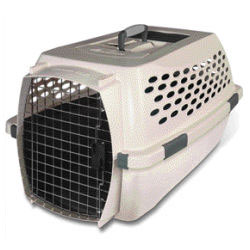
Kennel Cabs are available in sizes for cats and small and medium dogs.
Good For You and Your Dog
There’s no question – crate training your dog is the single best thing you can do to promote happy, healthy, and harmonious human/canine relationships in your family. Most of the problems that result in dogs being left at shelters: behaviours such as chewing, eliminating in the house, jumping up on visitors, separation anxiety, excessive barking, and more can be prevented through proper and effective crate training. This article provides information on the right ways to use your dog’s crate, and how to deal with difficulties that may arise.
Your Dog Is Not a Human!
A common belief among people who don’t really understand the nature of dogs is that putting a dog in a crate is cruel, that it’s like putting them in jail. This is an understandable reaction from a human who values freedom and considers their dog to be part of their human family. It’s only natural to feel that putting him in a crate would be mean and inhumane, and perhaps cause him to resent or even hate you, or maybe result in psychological damage. But you are not a dog, and your dog is not a human.
Dog crates have long been taken for granted by dog show exhibitors, obedience and field trial competitors, trainers, breeders, groomers, veterinarians, and anyone else who handles dogs regularly. Individual pet owners, however, often reject the idea of using a crate because they consider such enforced close confinement unfair, and even harmful, to the dog.
It’s very important that dog owners understand issues relating to dogs from a canine point of view. Dogs can’t see the world from a human point of view; it’s up to us to see the world from theirs. And for a dog, their crate is their own space, their retreat, their safe place, their security blanket. The crate helps to satisfy the strong denning instinct that is part of the nature of a dog. A dog that has learned to be in a crate will often choose to be in it even when he is not required to be. He is not afraid or frustrated when he is closed in; on the contrary he is happy to have that safe refuge. Dogs are more content and more secure having their lives controlled and structured by humans and would far rather be prevented from causing trouble than to be punished for it later. To you the crate may be a cage, but to your dog, it is home.
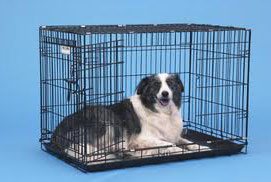
Wire Great Crates for all sizes of dogs.
Why Use A Crate?
Properly used, a crate provides many advantages for you and your dog. A crate can help you to:
- enjoy complete peace of mind when leaving your dog home alone, knowing that nothing can be soiled or destroyed and that he is comfortable, protected, and not developing bad habits. A crate keeps your dog away from potentially dangerous things such as toxic house plants, household chemicals, and electrical wires
- housebreak your dog more quickly by using close confinement to encourage control, establish a regular routine for outdoor elimination, and to prevent “accidents” at night or when left alone. A crate is an effective housebreaking tool because it takes advantage of the dog’s natural reluctance to soil its den
- effectively confine your dog at times when he may be underfoot, such as during meals or family activities, when his presence is unwelcome, such as when guests or workmen are in the house, or when he is overexcited or bothered by too much confusion or too many children, or when he is ill
- travel with your dog without risk or the driver being dangerously distracted or the dog getting loose and possibly lost, and with the assurance that he has his familiar “security blanket” along
Your Dog Can:
- enjoy the privacy and security of a den of his own to which he can retreat when tired, stressed, or ill. Dogs learn to love their crate as their very own special place. It becomes a familiar and secure place, at home, when away, when in the car, or wherever you and your dog may be.
- avoid much of the fear, confusion, and punishment caused by your reaction to problem behaviours
- more easily learn to control his bladder and bowels and to associate elimination only with the outdoors or other designated location
- be spared the loneliness and frustration of having to be isolated in the basement, garage, or outside when being restricted or left alone
- be conveniently included in family outings, visits, and trips instead of being left behind alone at home or in a boarding kennel
- You want to enjoy your dog and be pleased with his behaviour, and your dog wants little more from life than to please you. A dog crate can help to make your relationship what each of you wants it to be.
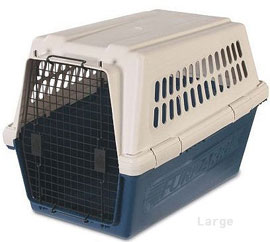
Furrarri crates come in a wide range of sizes.
What Size Should The Crate Be?
A crate should be large enough to allow the adult dog to stand, stretch out on his side without being cramped, and to sit up without hitting his head on the top. Appropriately sized, the crate will allow the dog to easily turn around. With a puppy, it’s best to start with a smaller crate and increase the crate size as he grows. Another option is to block off the back end so he is unable to use one end for sleeping and the other end for eliminating. Crate training uses the dog’s instinctual behaviour to keep his den clean, that is to not eliminate where he sleeps. Dogs that are kept in a bigger area are much harder to housetrain, because they have been forced to eliminate in their sleeping quarters.
Where Should The Crate Be?
Dogs are social animals, and should not be isolated. Confining the dog without making him feel isolated is really important, so don’t put the crate in the basement away from the family. The crate needs to be where the dog’s pack is, that is close to the humans, where he can be a part of family activities, even as an observer. This may be the kitchen or family room. If possible the crate should be moved around with you. At night, the crate should be in your bedroom. This provides comfort to the dog and allows him to adapt your own sleeping patterns. Having the crate nearby at night allows you to easily deal with any fussing that he might do.
Crating a Puppy
A young puppy (8 to 16 weeks) will normally have no problem accepting a crate as his own place. Any complaining or whining he might do at first is caused not by the crate, but by the process of his learning to accept the controls of an unfamiliar environment. In the majority of cases, the crate will help the puppy to adapt more easily and quickly to his new world.
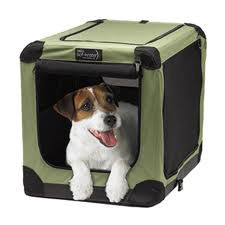
Collapsible yet sturdy, the Sof Crate is a terrific choice if you travel a lot.
How To Use The Crate
Be sure that children understand that the crate is not for them to play in, but that it is a private place for the puppy, and insist that this is respected. You must, however, accustom the puppy to letting you reach in to the crate at any time, and not allow him to become overprotective of it.
Never, ever use the crate as a form of punishment. All this will do is cause your dog to resent and perhaps be afraid of the crate. It’s very important that your dog learns that being in the crate is a good thing, and once this happens, most dogs are happy to go in their crate at any time. You can, however, use the crate for a time-out if your dog becomes exuberant or over active.
Note that it’s really important that your dog gets adequate daily exercise, for both his physical and mental well being. He needs to be able to burn off energy, which helps to promote calmness.
When you first introduce either a puppy or an adult dog to the crate, leave the door open and entice him to go in using treats or a favourite toy. The goal is to create positive associations with the crate. Feeding him in the crate will also help. Be patient. If he hesitates to go in the crate, be satisfied with him being near it at first. Try feeding him in front of the open crate door, then move his dish just inside the door, then gradually move it towards the back of the crate. Again, be patient.
Never force the puppy into the crate. During his introduction to the crate you want to keep it positive. Entice him to go in the crate with treats frequently, leaving the door open and allowing him to come right back out. Give him lots of praise when he does go in. Let him see you toss a treat in the crate and encourage him to go in and get it. Keep it positive, and be patient.
At first, when you close the door, stay with him and keep his confinement to very short periods. During this introductory time, don’t let him create an association with being in the crate and being alone. Gradually lengthen the periods he is in the crate. If things do not go too smoothly at first, don’t worry, just be persistent and be consistent. Remember, you are doing your dog a real favour by preventing him from getting into trouble while left alone.
Don’t take him out of the crate if he is fussing or whining, as that will only teach him to fuss or whine again. Wait until he stops for several minutes, and then take him out as a reward for being quiet. Keep this low key, you want him to learn that going in and out of the crate is not a big deal.
It’s important to realize that crating the puppy does not by itself teach him to be housetrained. You must use his natural instinct to not soil his den to teach him that outside is the proper place for elimination. First, be sure he has eliminated shortly before being put in the crate. As a rule of thumb, your puppy can be crated for the same number of hours as his age in months (e.g. three hours at three months). Immediately on taking him out of the crate, take him outside to the area you want him to eliminate in. Keep it strictly business – you are taking him out to eliminate, it’s not to play or have fun. As soon as he eliminates, give him a reward: tell him what a clever dog he is, give him a treat, or play with him. He’ll quickly learn the routine: crate, outside, pee, fun!
To be successful and housetrain your puppy quickly, you want to prevent him from making mistakes. Never let your puppy have the run of the house. He must either be supervised all the time or confined. If you have to leave the room, even for a minute, either take him with you or put him in his crate. Learn to anticipate the times he will need to eliminate, such as right after a sleep, after eating or drinking, after playing, and immediately after being in his crate for any length of time. Take him outside so he can eliminate and then reward him. If he makes a mistake, it’s not his fault, but rather it is yours. Do not punish him, the old “stick his nose in it” does not work.
With persistence and consistency, your puppy will quickly learn to go outside to eliminate.

Crate training makes for happy dogs and humans!
Crating The Adult Dog
Most of the common problem behaviours of adult dogs are caused by the lack of a feeling of security when left alone. A crate can provide the security he desires and usually solve these problems, but it must still be introduced gradually, and it is very important that the dog’s first association with it is positive and pleasant.
Does The Crate Always Work?
Most of the time? Yes. Always? No. Crates are used successfully by most dog owners, but there are some dogs which simply cannot or will not tolerate this form of confinement. This is not nearly as common with young puppies as with adult dogs, but it does happen, particularly with adopted or rescued dogs, dogs which may have suffered a traumatic experience while crated, or an unadaptable senior dog. In some cases a dog will use a crate readily as long as the door is open, but will object the moment it is closed or when he is left alone. These reactions definitely represent the small minority, and most dogs can successfully be trained to use a crate.
While a crate may not always work, it is always worth a try. When it does prevent or solve problem behaviour, it is truly the “best friend” you and your dog could ever have.
A Pet’s Life carries a wide range of crates, including Furrarri, Great Crate, Kennel Cab, Vari Kennel and Sof Crate. For more information and advice about the options and to find the crate best suited to you and your dog, talk to any of our knowledgeable staff.
The Power Of… Praise!
in Dogs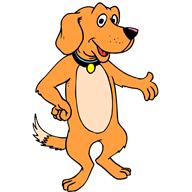 Good Dog!
Good Dog!
Two words that we most enjoy saying to our beloved canine companions and so it should be. I’ve been struck by the lack of attention paid to positive reinforcement in the popular dog training programs on television where so much emphasis is placed on obedience, discipline, and being the dominant “alpha” in your dog’s pack; which is ironic considering that for many years “Dominance Theory” in dogs has been proven to be greatly flawed. Dominance theory and its faults is something I’d like to talk about in a future article.
Not unlike our children, dogs need to understand the limits of what they can do and the consequences for exceeding those limits. For many years the popular focus in teaching our dogs was to; “Ignore the negative and only reward the positive behaviour.” Sounds ideal but in reality there are situations when a discipline communication is necessary for our dog to learn. For example: How is our dog to understand that they are not allowed to eat our underwear? By praising them when they are not dining on our undergarments? Clearly, this is not a situation where you can ignore the negative and only reward the positive.
There is a time for No but we must be vigilant in recognizing opportunities to say Yes. The more focus we place on the good they do; the less often we need to tell them… No.
It seems to be human nature that we are attentive to identifying the wrong our dogs do so that we can correct it but in doing so we often miss opportunities to accentuate the good behaviour.
It’s true that there is a balance of learning, in which we need to communicate to our dog how we feel about both the good, and the not so good they do but in my opinion the more important of the two is by far… accentuating the positive.
Praise is a powerful tool in teaching our dogs but like any tool, it can be ineffective if not used properly. I hope the following tips will help you in utilizing praise to its greatest potential.
The mechanics of effective praise (positive reinforcement).
Timing
I would say that the timing of giving your dog praise is the most critical facet of effective teaching. Praise too early and you may be rewarding your dog for doing something other than what you intended. Praise too late and your dog may not learn the lesson at all.
Timing is especially important when your dog is a puppy and just starting to figure out what and how you are teaching. When teaching a “recall”, if you deliver the cue for them to come to you, then as your puppy turns, starts to approach and you deliver an excited; “Good boy!!” as encouragement, there’s a chance that your pup will stop in their tracks and puzzle about what it was they were just doing that deserved your praise.
As your pup turns to approach and perhaps hesitates, it would be better to encourage them by repeating the signal for them to come, in a happy, excited voice and reserve your praise until the exact moment their nose touches your outstretched hand.
When teaching your dog to “sit”, you would wait until the very moment their bum hits the ground before praising. The same would be so when asking your dog to lie down. The dog reclines and gets a “Good dog!” Sometime we get complacent about the stellar behaviour of our canine companion and forget to praise. If it only happens once in a while… no problem but if we don’t praise their good behaviour at least intermittently the strength of the behaviour is going to fade.
I’ve met quite a number of folks who have a dog that will lie down whenever it is asked to sit. This happens because they have asked their dog to sit… then lie down; forgetting to praise their dog for sitting before asking them to lie down. Because the behaviours are not treated separately by the human, the dog; being the smart animal they are, recognize that they are asked to sit and then are rewarded when they lie down. Without positive reinforcement for sitting they will fast track to the identified goal… lying down.
Intermittent Reinforcement
This is an invaluable tool for maintaining the reliability of your dog’s response to your signals. Though you may give your dog a “Good boy/girl” each time they respond as you’ve asked; by using the intermittent reinforcement tool of delivering a treat each 3rd or 4th time they succeed is a great way of increasing the strength of the praise. Your dog will never be certain just when the added bonus is delivered and will respond eagerly each time… just in case. (This works with children as well.) (Don’t tell my daughter I told you this.)
Appropriate Intensity
When we are first teaching our puppies or even when teaching our adult dog something new, it’s important to make the lesson fun and exciting when they succeed. However, once they’ve learned something well, you can vary the intensity of your praise to match the quality of their response. For example; I call my dog to me and he comes but takes his time about it, stops and says hello to a dog or two and them ambles toward me and touches his nose to my hand. He did what was asked although not as well as is usual for him. Still… he did come and touch my hand so I will tell him “good boy” but calmly and casually. On the other hand; if I call for my dog and he breaks away from a group of other dogs, passes by three squirrels, six rabbits and a filled bowl with a sign that reads… Free Dog Treats, and passes by without deviation and rockets his nose toward my outstretched hand; he’s going to get a “GOOD… BOY!!!” a pocketful of treats, a tummy rub and a kiss on the head.
Dogs are indeed smart enough to recognize the difference in our reaction to their “good” behaviour or “awesome!” behaviour. Like anything else they learn from us, it takes a few times for them to recognize the pattern in our behaviour but they will learn… the better their response… the greater the rewards.
As well, there is such a thing as praising too much and too often. If our dogs get excited praise and a treat for every little thing they do, in time they will become desensitized to praise and the value of their reward would weaken and become less effective.
Make your rewards fit the quality of their behaviour and moderate the amount of times you praise and the rewards you give will mean so much more to your dog.
When Not To Praise
Sometimes we inappropriately praise our dog without really realizing it. For example: Rover is growling at somebody and you; feeling a bit embarrassed, lean down and ruffle their fur and say; “Oh for goodness sake Rover, stop being such a Mr. Cranky Pants.” Rover has just displayed an aggressive warning and your response was to pet him and talk to him pleasantly; essentially rewarding the aggressive behaviour. This is a circumstance that calls for discipline and redirection not praise.
In my mind the most important time to resist praising inappropriately is immediately after a discipline communication. Just about every dog trainer I’ve met teaches their clients to tell their dog No for doing something they shouldn’t and if the dog stops, praise the dog for being a good listener.
Firstly, this never happens among dogs. If Fido is getting too close to Rover’s favourite toy, Rover will become still, make eye contact with Fido, curl his flews and perhaps growl. Fido, taking the hint, will stop advancing and move away. When Fido has backed away to Rover’s satisfaction Rover will simply return to playing with his toy. At no time is there any indication that Rover turns to Fido and praises him in gratitude for being a good listener.
Behaviour is shaped by its final and strongest consequence. When you ask your dog to “Sit” and they do, the consequence to them is “Good dog!” and perhaps a treat. The consequence (Good dog! & treat) shapes their behaviour (they sit).
When a discipline communication is immediately followed by a rewarding communication it is a mixed message which weakens or negates the discipline.
Your dog misbehaves and is told No! She stops what she’s doing, looks up at you then immediately hears… Good girl! Your intent is to reward her for stopping but at the least you are sending her a mixed message. Unfortunately, we are often so tickled that our dog listened and stopped what it was doing, that we heap on the praise because we want our dog to be aware how happy we are that they listened. From Rover’s perspective she is hearing a “No…bad dog.” from you and stops to figure out what you are talking about then immediately hears… “Good girl! What a good girl you are!”
Rover will be pondering; “Geez you were so cranky for a moment there but just a few seconds after were really happy and complimentary. What was I just doing? Oh right! I was just about to eat that underwear! Well… he seems to be quite happy with me so I’ll carry on.”
It’s tough to tell your dog to stop doing something and not reward them for listening to you. It feels counter intuitive but it’s the doggy way. Reserve praise for those times when your dog makes good decisions without being told No.
Many anxious and fearful dogs that I have worked with have become confident and trusting because their owners stopped delivering angry, agitated discipline followed by praise for good listening and instead learned to deliver calm discipline and dispensed with praise for good listening. With calm assertion and no mixed messages that are confusing, their dogs better understand what is being communicated and quickly gain confidence allowing their anxieties to melt away.
© 2011 Steve J. Huxter All Rights Reserved
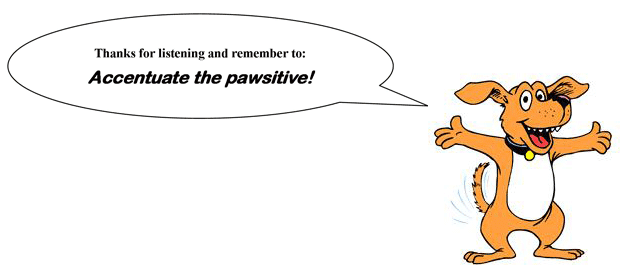
HOME ALONE and very afraid.
in DogsWhen Your Dog Has Separation Anxiety
Separation Anxiety is a crippling state of mind for a dog. It is heart rending for owners to see the manifestations of their dog’s fear when they are left alone. Dogs are inherently social animals that crave being part of a group or pack. For some dogs, being separated from their pack and family causes intense fear.
It is a behaviour that is sometimes formed early in a dog’s life. It can be caused by experiences such as the loss of a mother before eight weeks of age. Isolation from lack of companionship between eight and sixteen weeks of age, abandonment by a previous owner, dramatic changes in their environment, and even breeding may be the cause for separation anxiety. Dogs that have been strays or were in a neglectful or abusive circumstance which are re-homed and then receive all the love and affection they deserve can become separation anxious due to their fear of losing their new life circumstance whenever their guardians leave them on their own. In some cases “anaclitic depression” can occur. One form of anaclitic depression concerns itself with what happens if the attachment to a dog’s caregiver is disrupted for a long period of time during the dog’s first year of life. The other may be more likely to occur in an adult setting, when a dog forms an extremely dependent attachment on others: dog or human. This “depression” can manifest itself as an extreme fear of being left alone that may result in a refusal to eat or relax when alone and anxiety and neediness even when you are together.
One of the most common manifestations of behaviour with dogs experiencing separation anxiety is excessive vocals, whereby the dog whines or barks incessantly, or destructive behaviour when the dog is left alone. Especially, “point of entry destruction”, which takes place at the doorway where the dog’s owners typically leave the home. Scratched doors, chewed door frames or door handle. I’ve seen flooring ripped up at the doorway, side windows cracked and some years ago, a German Shepherd I helped had ripped the metal mail slot right out of a solid wood door.
There are many reasons why a dog may misbehave when left alone but if your dog fits the profile of an animal who might be prone to separation anxiety and if your dog is only destructive or eliminates inside when no one is home, and does not display this kind of behaviour at any other time, separation anxiety is most likely the problem.
When your dog chews destructively when left alone, it is not being vengeful for having been left alone. Chewing helps a dog feel better when it is anxious. It’s distracting and helps relieve nervous energy. Dogs are sometimes more likely to chew something that smells of their human companion, such as a shoe.
When dogs are anxious they often do not have the same control over their bladder and bowels. The more anxious they become, the less likely they are to be able to wait until they are let outside. It could also be possible that there is some scent marking that occurs with the house soiling, it comforts the dog, knowing that its living area is filled with its familiar scent, though this is more likely in the case of a dog that is new to a home.
Prevention
We can avoid the possibility of our dog becoming separation anxious by setting them up for success the moment they enter your life and home. Following some of these guidelines can be very helpful:
- Allow your puppy time to be alone. If your pup chooses to have alone time for a nap or to play by itself, allow it to do so. If you suddenly notice that your pup is nowhere in sight, do check on its location in your home but let them spend time alone. When a pup joins a family, all the family members want their snuggles or play time with the pup. The larger the family the more likely that the pup’s day and evening will be filled with attention, so be sure to let your children know that your new family member needs alone time. It can be helpful to schedule downtime for your pup and make certain everyone follows the schedule. If you are scheduling alone time it should be varied throughout the pup’s day so that a pattern of behaviour is avoided.
- Within a few days of the pup’s arrival begin introducing the puppy to the experience of being alone as the family leaves the house for an outing. You will want to constrain your puppy to its introductory living area; usually an area that can be closed off and has tile or wood flooring for the inevitable potty accidents. (I don’t recommend using the bathroom for this learning experience.) Another good option, especially if you don’t have an area of your home where you can easily contain your pup, is to introduce your pup to being in a crate or kennel. This assists with housetraining and prepares your pup for those times when you may need to kennel your dog when travelling. Leave your pup on its own for a few minutes while you go for a short family walk and gradually over the next week or two, work your way up to an hour. (Ed. note: For a specific article on crate training, click here)
- Departures should be calm and matter-of-fact. No hugs and kisses goodbye and no need for assurances that you are only going for a short while and will be back soon. Simply set your pup up in its area with water in place then out the door you go. The more that your departure is a non-event the less worried your pup will be about your leaving.
- Your arrivals are by far the most important part of this experience for your pup. It is vitally important that on your return, you must not match the level of excitement that your pup displays on your return. Your puppy is going to be very excited to see you and we are very gratified and excited to see our puppy but… you must display a calm greeting and send the message that being apart is no big deal. Please don’t worry that if you don’t act excited to see your pup, they won’t feel appreciated. Do feel free to make eye contact with your pup and offer a smile and you can even say hello as long as your voice does not sound excited or higher pitched. But if your greeting produces an excited response you need to mellow your greeting. Once you’ve been back with your pup for 5 minutes or so and your puppy has calmed down (relatively speaking), you can interact and play with your pup as you normally do. It is that first few minutes of greeting that can possibly reinforce their fear at being apart from you.
Your excited puppy might simply be thinking… Yahoo! It’s play time again! But there’s a possibility their thoughts are… They’re back. I’m going to live!!
Managing Separation Anxiety
Though the experiences of the past that created your dog’s anxiety cannot be undone, it is possible to diminish the experience and train your dog to accept being left alone or reduce their general anxiety level. Utilizing a behaviour modification program, designed specifically to meet the needs of both you and your dog, it is possible to help your dog understand that they have not been abandoned whenever they are left alone.
Since the reason for a dog being separation anxious varies, and every dog, living circumstance and behavioural manifestation of the anxiety differs, the cure very much needs to match the ability of the dog to learn. The most challenging aspect of resolving your dogs anxiety is… time. There is no fast-track to resolution. If you try to progress too quickly your dog is likely to fail and you will experience set back after set back. However, there are some standards of approach to resolving separation anxiety.
No big deal departures.
Departures should be very calm and matter-of-fact. No hugs and kisses goodbye and no need for assurances that you are only going for a short while and will be back soon. Simply set your pup up in its area or kennel if you are using one with water in place then out the door you go. The more that your departure is a non-event the less worried your dog will be about your leaving.
There are cues that trigger the start of your dog’s anxious behaviour such as grabbing your keys or putting on your shoes or coat. It can be helpful to avoid a pattern of preparation to leave. Put your keys in your pocket well in advance, place your shoes outside before you leave, etc. It can also help to put on your coat or pick up your keys or shoes and simply walk about your home for a few moments then put down you keys, take off your coat and so on. By handling those triggers randomly and at times not even leaving your home, your dog should become desensitized to them as being cues that you are about to leave.
Greetings when you return.
Whenever greeting your dog, at any time, make your greeting very calm and matter-of-fact by making short eye contact and delivering a calm greeting. Many trainers recommend that you completely ignore your dog when greeting them; however it has been my experience that some dogs will jump through hoops trying to gain your attention. I feel that there is value to making short eye contact as a quick acknowledgement but thereafter do not look at, speak to or touch your dog until they are calm and relaxed so not to reinforce their anxious excitement.
Even when they have relaxed and you feel the timing is right to say hello, be sure to make your greeting very calm and mellow.
Alleviate “needy” behaviour
If ever you suspect that your dog is coming to you for affection/support because they are anxious, it would be wise to ignore the “needy” behaviour and give them your attention/affection when they are in a more relaxed state of mind and less fearful. This is a subtle way of helping them confront their anxieties on their own so that they learn that the world won’t come apart for them without your support. Recognize that your dog is seeking your attention but patiently wait for them to relax and give them your affection at a time when you won’t be inadvertently rewarding their anxiety and neediness.
Practice coming and going as often as possible.
The only thing that desensitizes animals to a fearful circumstance is for them to confront their fear by experiencing the circumstance time and time again until they come to realize that their life is not threatened, and in the case of separation anxiety, that there is no terrible consequence to being left on their own. We can hasten the process by helping them learn the lesson in small ways many times. The more often they experience your calm and nonchalant departures and especially… arrivals, the quicker they will learn.
You can begin this process by simply going into one of the rooms within your home and close the door behind you, leaving your dog by themselves for a minute or two. Make certain they see you going into the other room. After a minute or two open the door and exit the room making short eye contact but not engaging them in any way until such time as they are displaying calm and relaxed behaviour. Once they are more relaxed give them simple praise for being calm and if they remain relatively calm then interact with them as you normally would.
In addition to practicing within your home you should also practice exiting through the door leading outside your home. Initially, only for a few moments and then begin increasing the amount of time you are outside as you see less anxious/excited greetings when you return.
When practicing separations from your dog, when you intend on re-entering your home try do so before they start to bark, whine or scratch at the door, otherwise they may learn that their barking or scratching encouraged you to return. Wait for a 30 second break in the barking or scratching and then open the door.
Once their greeting to you is calmer during a short exit/re-entry you can start extending the amount of time that you are separated from them.
When you can successfully exit and re-enter your home after a 15 minute practice separation and your dog is happy to see you but not displaying an anxious-excited greeting, you can start to do those things that you would normally do when actually leaving the house. Put on your coat, pick up your car keys, etc., as you would if you were going to work, an appointment, shopping, and so on.
Crating or Kennelling
As a rule I encourage dog owners to teach their dogs to accept being in a crate or kennel. It is best to start this when your dog is a puppy and can be necessary to constrain your pup from getting into mischief when you need to go out; especially if your “open concept” home doesn’t allow you to close off a particular area of your home. As well, if you like to travel and kennelling your dog will be necessary for air travel, etc., it will be especially stressful for your dog if they have not been trained to accept being in a kennel.
If your dog has minimal or no experience being kennelled, I do not recommend crating or kennelling a dog suffering with separation anxiety. Even for those dogs that have previously been comfortable in their kennel it could possibly be detrimental to place them in a kennel when they are separation anxious. Contrary to popular belief, it does not help them feel like they are in their comforting den. Instead it provides a more intense feeling of being restricted from searching for you and greatly increases their anxiety and fear. Once a feral dog has left the den they do not desire returning to their den as a comforting experience. (When was the last time you wished to be back in your crib when you were having a stressful day?) I’ve worked with a few dogs whose owners were advised to crate their dog which resulted in the dogs injuring themselves and suffered lacerations and broken teeth in their feverish attempt to escape the kennel.
Medication to support training.
There are a few medications that can be very helpful in resolving severe cases. One such medication is Clomicalm (clomipramine hydrochloride). It is designed and approved for the treatment of separation anxiety in dogs. It is not a tranquilizer or a sedative, and will not affect your dog’s personality or memory. The medication helps to lower a dog’s anxiety level making it easier for your dog to learn. The medication alone will not resolve the separation anxiety it must be accompanied by behaviour modification support from an experienced animal behaviourist or trainer.
Measuring progress and success.
Throughout the process it will be important to measure your dog’s reactions when you are returning after being separated. Always keep in mind their level of excitement whenever you return after a separation and look for indicators that the level of intensity in their excited greeting is lessoning.
Observe their body movements that indicate levels of excitement such as:
- Rapidity of tail wagging. (very active, moderately active, calm active.)
- Is their hind end moving vigorously or gently?
- Do they appear extremely submissive by dropping their head down and turning their head slightly to the side (anxious) or does his head drop down a bit but remains straight? (confident)
- Does their body bend as he greets you (anxious) or does their body remain fairly straight (confident).
As they become desensitized to being separated from you, their greetings will still be energetic but less so as they progress and are less concerned about being away from you.
Success is when their greeting to you is head up, body straight, tail gently wagging but a fairly relaxed hind end. Ultimate success is when you arrive home and have to go looking for them in order to say hello.
© 2011 Steven J. Huxter. All Rights Reserved
Spare The Rod, Spoil The Dog?
in Dogs Why, When and How to Say No to your dog.
Why, When and How to Say No to your dog.
Likely the most discussed and disagreed upon facet of guiding and teaching our canine companions is…. discipline.
It’s one of those facets of dog behaviour about which it’s said that the only thing two trainers might agree on is that the third trainer is doing it wrong.
Of course we need to tell our dogs no… but do so in a canine familiar style and structure. This does not include swatting with a newspaper, squirting lemon juice in their face or “pinning” the dog to the ground. If we discipline our dogs too aggressively they will fear, not respect us. People who rely on dominance theory to train their pets may need to regularly threaten them with aggressive displays or repeatedly use physical force. Conversely, pets subjected to threats or force may not offer submissive behaviour, instead, they may react with aggression, not because they are trying to be dominant but because the human threatening them makes them afraid; they are simply protecting themselves.
Why say no?
I would have to say that a large percentage of behavioural issues I am called upon to resolve are based on discipline that has been applied too harshly, inconsistently or the more common… little or none at all.
Dogs are no different than any other social species on our planet in that they benefit from an understanding of the limitations and boundaries of their social environment. If someone is not there to set those limits and teach them as to where the boundaries lay the consequences could be grievous.
It’s common knowledge that our children need guidance, limit setting and effective consequences for misbehaviour. Our dogs are no different. Under normal circumstances these lessons would be taught by a puppy’s mother but when at eight weeks of age a pup is transferred to the care of a human, we must assume the parental responsibility. If not, our adorable puppy may grow to become a frustrating nuisance.
The Dominance Theory effect.
Many people have an instinctive dislike for the thought of “dominating” their dog and with no other tools offered, apply little if any discipline. Other dog owners fall too easily into the role of dominating their dog.
For decades dog trainers have relied upon the theory of social dominance behaviour in wolves as the cornerstone of training and managing dog behaviour. We were taught that we must be tough disciplinarians with our dogs otherwise they will run amuck. I heard of one trainer who taught students that all dogs are potentially aggressive and yearn to dominate you. If a dog was stubborn and disobedient it was necessary to badger the dog until they became aggressive in order to exert our dominance and have the dog understand who the Alpha in the pack is.
Closer to the truth is that there is indeed a pack leader but rather than a “hard as nails General” in charge of the troops; the leader is more like a patriarch/matriarch. The pack is more like a family unit with Dad and Mom guiding the family. There is dominant and submissive behaviour within the pack members but the expressions of the behaviours are subtle.
Dominance and leadership are not synonymous.
Leadership should be attained by more positive means – by rewarding appropriate behaviours and using desired resources such as food, toys or affection as reinforcement for these behaviours. Leadership is established when a dog owner can consistently set clear limits for behaviour and effectively communicate the rules by immediately rewarding the correct behaviours and preventing access to or removing the rewards for undesirable behaviours before these undesirable behaviours are reinforced. Owners must avoid reinforcing undesirable behaviours and only reinforce the desirable behaviours frequently enough and consistently enough for the good behaviours to become a habit.
With so much focus on dominance and discipline we spend more time saying No and not near enough time guiding our dogs by teaching them what it is we desire from them.
We very much need to say No to our dogs but we need to do so with patience and persistence rather than using force and coercion.
When to say no.
Timing is very important and your dog will understand you better if it is easily able to relate your discipline communication to what it is they are doing that merits your displeasure. If you arrive home and the first thing you see is the chewed table leg and start angrily berating your dog as it approaches you tail wagging and eager to say hello; you can well imagine the effect this could have on your relationship. In this situation your best response… is none at all; except to recognize that boredom, teething or anxiety led to the chewing. Address why the dog is chewing and the chewing will stop.
An absolute of applying discipline with dogs is that you must follow through and teach the lesson each and every time. The lesson must be calm, assertive and most importantly; delivered without fail, each and every time the misbehaviour occurs. Dogs learn by identifying patterns of behaviour and communication from us. When we apply discipline inconsistently it breaks the pattern of our behaviour making it more difficult for our dog to learn. Many dogs that appear stubborn and obstinate to change are more likely not understanding what we want from them.
There are occasions when we don’t have to wait for our dog to commit the misbehaviour before saying No.
For example: Your dog has discovered it can steal food off the kitchen counters and table. You can more effectively teach your dog that food on the table or counter is off limits by consistently disciplining your dog when they simply display interest in the food. Every time you see your dog raising their nose to table or counter level and sniffing to locate the food; tell them No for simply displaying interest. After twice telling them No, if they don’t move away then step between your dog and the source of their interest and back them away a step at a time until they defer and move away.
Because each dog has a different personality and the circumstances and motivation for the misbehaviour differs; the use of discipline and the form it takes needs to be carefully considered. If your dog jumps up excitedly at visitors to your home, should you reprimand your dog for being happy to greet visitors or would it be better to teach your dog a more self-controlled greeting style. It’s easy to say… No. But, it takes patience, imagination and perseverance to do the work of teaching your dog to greet visitors more calmly.
When NOT to say no.
We should not be disciplining our dogs is when we are teaching them. If you are training your dog to sit, lie down or walk properly and they are reprimanded when they fail, you can imagine the result… a dog that does not want to learn from you. If a dog fails when learning it simply means they don’t yet understand; which means your task should be to patiently clarify and repeat the lesson. If you begin to feel frustrated then end the lesson and try another time. If you aren’t having fun teaching, your dog won’t be having fun learning.
Take care not to discipline the wrong behaviour. At the dog park your dog jumps up on another person leaving muddy paw prints. Horrified, you call your dog to you and on their arrival tell them what a bad dog they’ve been. Are you disciplining their jumping up or for coming to you when you called?
Separation anxiety. When a dog is separation anxious they may bark or howl, chew or scratch destructively and may urinate or defecate in the home. These are all symptoms of their fears and help to relieve their stress. This is not an occasion to apply discipline. Reprimanding them for barking, being destructive or messing in the home will only increase their fear and anxiety. By working to resolve their fear at being separated from you the barking, destruction or messing in the home will go away. (Click here for an in depth article on separation anxiety.)
How to say no.
- Applying discipline should be done calmly and with certainty. The application of a discipline communication should never be done in frustration or anger.
- The most effective canine leader is one who delivers discipline calmly, yet with strength and certainty. Agitated-aggressive leaders are feared, not respected.
- Use simple sounds or words (Rover… No! or Rover… Hey! etc.) It’s said that by using your dog’s name before delivering a discipline communication the dog will learn that its name is a negative. This would be true if “Rover… bad dog”, was the only communication you ever made to your dog. Dog’s can easily differentiate between a discipline tone and happy tone to our voice. In multiple dog homes it is especially important to clearly identify who is being disciplined.
- Avoid higher or excited sounding tones of voice. Calm and firm, lower tones of voice are more effective. Avoid having a lilt to your voice. The words should be spoken in a monotone. Take care not to sound aggressive or angry, especially with dogs that have an anxious disposition.
- Timing is very important. Delivery of a discipline communication must take place at the very moment your dog is displaying the undesirable behaviour.
- Get close to your dog as soon as possible after the first discipline communication in order to amplify your assertiveness and let them know you are serious. If your dog is barking at the window; tell them No; then immediately move to them and stand close to amplify your presence.
- Eye contact is very important. When delivering a discipline communication look at your dogs eyes and continue to stare at your dog until such time as you determine that the discipline has been effective and your dog has stopped what it was doing and has relaxed, moved away, lay down, etc. Although your dog will not continually make eye contact with you, keep looking at your dogs head and eyes for that opportunity when your dog will make a quick glance toward to check if you still mean business.
- Use the same discipline communication for all circumstances. By using the same word or phrase every time discipline is communicated, your dog will more easily be able to identify what it is they shouldn’t be doing. Dogs make a connection between the communication they are hearing and what they are doing at the moment. It is unnecessary to use a variety of discipline words for different circumstances.
- Do not praise after applying discipline. Behaviour is shaped by its final and strongest consequence. If a discipline communication is quickly followed by praise it weakens the discipline. Because we are so tickled that our dog listened well and stopped what it was doing we inevitably deliver high praise which usually is much stronger than the discipline communication. No mixed messages. In the dog world; No simply means…No. If Fido is getting too close to Rover’s favourite toy, Rover will become still, make eye contact with Fido, curl his flews and perhaps growl. Fido, taking the hint, will stop advancing and move away. When Fido has backed away to Rover’s satisfaction Rover will simply return to playing with his toy. At no time is there any indication that Rover turns to Fido and praises him in gratitude for being a good listener.
- Exude assertive energy, follow through and be certain you succeed every time.
These are the basics of applying discipline to our canine companions. However, each and every dog is different, as are the motivations for what we call misbehaviour. There are many variables involved in determining the motivation for a dog’s misbehaviour. Often it is better to address the cause rather than focussing on discipline.
After many decades of study we are still learning about the subtleties of canine behaviour. Knowledge that we were confident in five decades ago is being pushed aside by more recent research. Unfortunately there are many dog trainers whose understanding of dog behaviour has not kept up with the greater understanding we have today and continue to use techniques of applying discipline that are unnecessarily aggressive and result in dogs that become increasingly fearful and/or aggressive.
If your canine companion has behavioural issues that challenge your patience and no matter how often you say NO! things just don’t change; it’s time to consult a professional. When you do, don’t be shy about questioning the reason for the type of discipline they recommend, especially if you feel uncomfortable with the techniques because they feel too harsh and aggressive. If the explanation given doesn’t make sense to you; trust your instincts and get a second opinion.
A skilled trainer will be focused on identifying and resolving the cause of the misbehaviour so that the need to apply discipline is minimized.
A less skilled trainer will recommend that you aggressively dominate your dog and use punishment to force them into compliance.
© 2011 Steven J. Huxter. All Rights Reserved
“Because fear and anxiety are common causes of aggression and other behaviour problems, including those that mimic resource guarding, the use of punishment can directly exacerbate the problem by increasing the animal’s fear or anxiety. Overall, the use of dominance theory to understand human-animal interactions leads to an antagonistic relationship between owners and their pets.” (American Veterinary Society of Animal Behavior – 2007.)
Is Your Pet In Pain?
in Cats, Dogs When we hurt, we’ll likely treat it ourselves if it’s minor, or if it’s more significant we can explain it to someone else, such as a doctor, and get help from them. Our pets can hurt too, but they can’t come and tell us, at least not directly. It’s our job to understand how our pets tell us that they are in pain and then to do what’s necessary to ease their suffering.
When we hurt, we’ll likely treat it ourselves if it’s minor, or if it’s more significant we can explain it to someone else, such as a doctor, and get help from them. Our pets can hurt too, but they can’t come and tell us, at least not directly. It’s our job to understand how our pets tell us that they are in pain and then to do what’s necessary to ease their suffering.
While pain is sometimes obvious in our pets, such as when they hold up a sore leg, at other times the evidence can be very subtle. Cats are particularly inclined to hide their pain, as they see it as a sign of weakness and vulnerability. Many dogs will do their best to camouflage their pain as well.
To know when your pet is hurting, you need to watch for subtle changes in behaviour and appearance that might indicate he is in pain. It’s vital to always be alert to these signs, as quick action and treatment is the best way to allow your dog or cat to heal and resume their normal, happy life.
Following is a fairly comprehensive list of the signs that your pet may be in pain. None of these alone is conclusive evidence, but a combination may well be indicative. You know your pet best, and therefore you are in the best position to know when he might be in pain.
Vocalization
- grunting or groaning
- whining or crying
- howling or whimpering
- yelping or growling when touched
- lack of vocalization when they normally would
 Hiding (mostly in cats)
Hiding (mostly in cats)
- withdrawal from social interaction
- not coming out to eat
Posture Changes
- shifting position more frequently than normal
- hunched up
- sitting or lying in an abnormal position
- preferring lying to sitting or standing
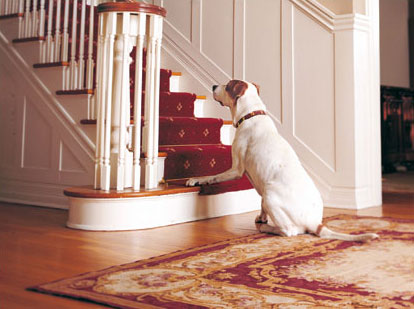 Abnormal Movement
Abnormal Movement
- difficulty getting up from lying or sitting
- lagging behind or tiring on walks
- limping, or not putting weight on a limb
- reluctance to go for walks or climb stairs or jump up
- reluctance to move at all
- repeatedly getting up and lying down
Breathing
- panting excessively, especially when resting
Changes in Behaviour
- out-of-character aggressiveness
- growling, hissing, biting, especially when touched
- unusual lack of responsiveness to situations, such as playing with a ball, or going for a walk
- avoiding being held or picked up
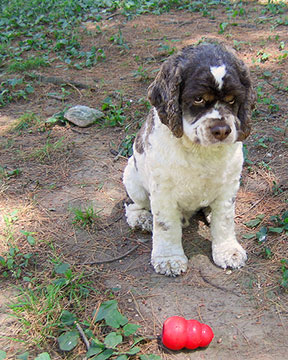 seeking more affection than normal
seeking more affection than normal- changes in bladder or bowel habits
- excessive sleeping
- restlessness
- shivering or trembling
Appetite
- changed, most likely decreased
Grooming
- coat lacking its normal shine
- unkempt appearance
- licking, biting, or scratching a particular part of the body
Expression
- staring vacantly
- grimacing
- glazed, wide eyed
- flattened ears
- enlarged pupils
- excessive grooming
Remember that the most important thing to notice is when your pet is not acting normally. Our cats and dogs are usually quite predictable, so when they act or appear differently than usual, it may be that they are in pain.
 What To Do
What To Do
It might be tempting to give human over-the-counter pain medications such as ibuprofen, acetaminophen, or aspirin to your pet. But the possibility of unforeseen side effects and the uncertainly of determining the correct dose is enough reason not to do so. Take your cat or dog to your veterinarian, get a full and complete diagnosis, and work with them to determine the best course of treatment.
Teaching Your Dog To Swim
in Dogs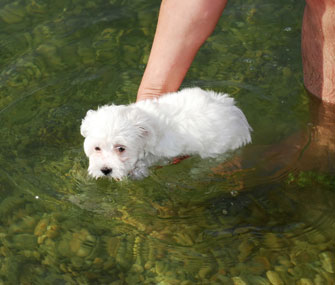 I was enjoying a sunny afternoon at the beach, in search of washed-up treasures in the sand. A young couple arrived, along with their Dachshund puppy, who had evidently arrived for his first swim lesson.
I was enjoying a sunny afternoon at the beach, in search of washed-up treasures in the sand. A young couple arrived, along with their Dachshund puppy, who had evidently arrived for his first swim lesson.
The little dog trotted to the water’s edge, and with a display of bravura equal to that of a Great Dane eyeing a plastic mouse squeaky toy, began to bark loudly and fiercely at the water.
Then, of course, he made an about-face and skedaddled back to his beach towel!
His owner picked the little puppy up, and headed back to the water with the dog in his arms. Slowly, he lowered the dog so that the puppy’s feet just barely touched the water. The dog’s legs began to whirl as he was gradually lowered into the water, to the delight of everyone watching. By the end of the afternoon, the Dachshund had conquered the mighty ocean (in his mind, certainly) having taken a few swims all on his own!
Some dogs take naturally to water
A breed of dog with the word “water” in its name (Irish Water Spaniel or Portuguese Water Dog, for example) should adapt easily to swimming. Setters, Retrievers, Akitas, Terriers, and Poodles are also strong swimmers, who love to play, hunt, and retrieve in the water. Some breeds (such as Cocker Spaniels, Labrador Retrievers, Newfoundlands, Chesapeake Bay Retrievers, and Nova Scotia Duck Tolling Retrievers) have specific features designed to help them become skilled swimmers: such as oily or wiry coats that repel water, webbed feet for additional propulsion, and thick tails that act as rudders.
Some dogs are not designed to become swimmers
Snub-nosed varieties of dogs, (Bulldogs, Boxers, and Pugs, for example) who are prone to breathing difficulties on land should not be expected to become proficient swimmers. Breeds with short legs, such as Corgis, Bassett Hounds, and Dachshunds are usually not comfortable in the water. But just like humans, sometimes a dog’s unique personality and desire are strong, making them determined to succeed – just like that little Dachshund getting his water wings.
 Help your dog learn how to do the dog paddle!
Help your dog learn how to do the dog paddle!
Your dog’s first experiences while learning new skills can set the tone for her future frustrations or accomplishments. It may take lots and lots of practice to teach your dog how to swim, or perhaps after one or two dunks your pet will love swimming with you any chance she gets. In either case, try to make her lessons fun for the two of you.
You may want to enlist the help of a dog who is already a good swimmer, and one your pet is friendly with and used to being around. If you can handle more than one dog comfortably, or have friends to help, having your pet watch other animals relax and swim in the water may be a great way to help a novice overcome her initial qualms, and gently coax her into the water as she naturally mimics a pack leader.
Try to avoid teaching your dog to swim in a river – currents may be fast and treacherous. A lake, pond, swimming pool, or calm ocean inlet are all good places to start.
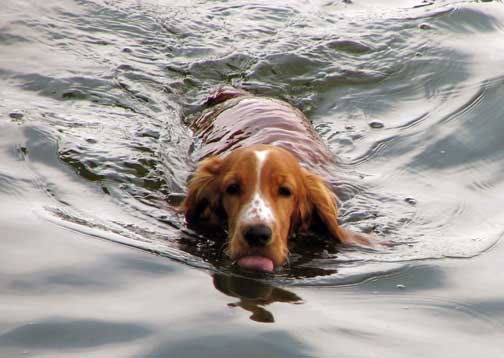 Choose a quiet location – too much noise (and too many people) may be alarming and definitely a distraction.
Choose a quiet location – too much noise (and too many people) may be alarming and definitely a distraction.- Never scold your dog – always teach with love, words of praise, and treats.
- Never force your dog by throwing, pulling, or pushing her into the water and expect her to magically swim – these techniques may only make her fearful, and anxious to get out of the water as quickly as possible.
If you have a toy breed, puppy, or small dog:
- Go in the water with your pet and cradle her under her tummy while you teach her how to paddle.
- If she only paddles with her front legs, try holding her rear end up a little to get the back legs working (get her “running” in the water).
- A dog who uses only her front legs will expend too much energy and may sink.
- A dog’s natural head position should be relaxed, above the water, and slightly forward.
Follow the above suggestions, and allow your dog to swim as you support her tummy and chest, until you feel she is becoming comfortable and relaxed.
Try letting go for a few seconds—if all goes well, gradually increase her “free swim” until she no longer needs your support.
For taller or older dogs, or dogs who seem comfortable getting into the water initially:
- Let her walk towards you in the water as you slowly back up. Continue to back up into deeper water, until she can no longer touch bottom. If she begins to swim towards you, continue backing up a little more, offering her lots of praise and encouragement. If she becomes fearful, offer her the same praise and encouragement while you turn her around and both head back to shore.
 Teach your dog how to get out of the water!
Teach your dog how to get out of the water!
Most dogs only become fearful and panic-stricken in a body of water when they can no longer feel the bottom. Don’t allow them to become frantic as they try to escape – teach your pet how to get in and out of the water calmly – if you swim in a pool, train her to enter and exit only by the stairs, and if the dog is small, consider putting bricks or additional steps on the stairs to help the dog’s short legs gain their footing easily and securely.
Don’t let your pup poop herself out!
Swimming is a great exercise, but should be exercised with great caution! An excited or nervous dog may not have the same amount of stamina as she does exuberance – take frequent rest breaks, and if you are swimming in the ocean, be aware of the tides. Outgoing tides have a lot of pull, and can move humans and animals far from shore very quickly, sometimes to distances that are just too great for either to surmount.
If you plan to do a lot of swimming, water sports, or boating with your dog you should consider fitting her with a flotation device and getting her used to wearing it comfortably while swimming.
Remember it’s almost impossible to put on a life-saver in a state of panic during an emergency. Your dog’s flotation device should be securely attached prior to her entering the water. Some flotation devices have handles on top so that you can grab the animal and lift her up and out of the water.
Learn mouth-to-nose resuscitation
A catastrophe can happen in seconds, and you only have a very small window of opportunity in which to provide life-saving measures. Proper training in mouth-to-nose resuscitation, as well as effective chest compression techniques for a dog in distress can be the difference between life and death.
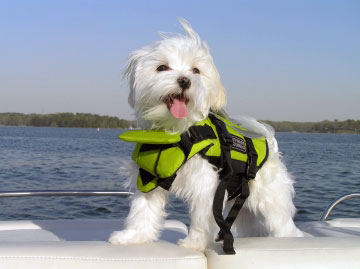 Small animal first aid training courses which include resuscitation are available. A Pet’s Life sponsors a comprehensive course, and more information can be obtained here or by sending an inquiry to info@apetslife.ca.
Small animal first aid training courses which include resuscitation are available. A Pet’s Life sponsors a comprehensive course, and more information can be obtained here or by sending an inquiry to info@apetslife.ca.
Even if the animal resumes breathing on her own, always take her to the veterinarian immediately.
Plan for safety and fun
Dogs can get sunburned, too! Their paws, noses, and ears are directly exposed to the sun, as is the skin of all short-haired animals, animals recently groomed for hot weather, and albinos, and are therefore prone to burning. Speak to your veterinarian about purchasing a sun screen for your pet, and use it as required. You might consider a pet T-shirt for coverage as well.
Try to rinse your pet off as soon as possible after swimming – the salt from the ocean or the chlorine from a pool can cause damage to your pet’s fur, skin, eyes, and ears. Make sure to dry her ears well, and wrap small dogs (or any shivering animal) in a dry towel or blanket. Body heat can dissipate quickly, and your pet might be colder than normal from the exercise and fresh air.
Remember to teach your dog not to drink the water in which she is swimming! Supply her with lots of cool fresh or bottled water. Salty, chlorinated, or polluted waters can cause mild to severe tummy upsets, or sometimes even life-threatening illnesses.
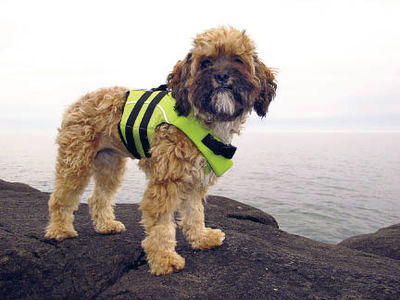 Large meals right before swimming are not a good idea, but your pet will be hungry and thirsty at day’s end.
Large meals right before swimming are not a good idea, but your pet will be hungry and thirsty at day’s end.
Watch your pet while she swims. A happy dog may not want to leave the water, even if she has become tired. If you notice your dog is panting excessively or wheezing, it’s time to take a rest break!

